The Best Electric Composters, Tested & Reviewed: Which Machine Is Best for Reducing Your Food Waste?

Table of Contents
If you’re an environmentally conscious person that’s ever left food scraps on your plate or counter after cooking a meal, you’ve probably felt a twinge of guilt as you scrape it into the trash. After all, food scraps make up a large amount of what we throw out — combined with yard waste, almost 30%. The best electric composters can make that twinge of guilt disappear, as they offer a convenient and mess-free alternative to traditional composting.
Compost is an organic material derived from this food and yard waste — you can add it to soil to help plants grow, which is why it’s useful for both amateur and professional gardeners who don’t like chemical-based fertilizers. Municipal composting is available in some locations, but it’s impossible to control the nature of the end product. Using an at-home composter is a great way to minimize that waste, at least, in theory. In reality, home composting can be messy, and outdoor compost bins can attract all manner of pests, from curious rodents to beehives. Electric composters, also known as food cyclers, are a novel alternative.
Today's Top Deals
Amazon's #1 Best-Selling Teeth Whitening Strips Are Now Just $30
Prime Day Deal Alert: Calvin Klein Underwear Is 30% Off For a Limited Time
The CEO of Pela, the brand behind the new electric composter Lomi, told SPY, “Recycling food and other organic waste into compost provides a variety of environmental benefits. Using compost helps grow healthier plants, reduce landfills, save water, improve soil properties and decrease the need for chemical fertilizers.”
While there are plenty of compost bins and manual compost machines on the market (usually powered by a tumbling motion), most are space-consuming, smelly, and not as effective as the best electric composters. These appliances do carry a higher price tag, but there are many reasons these food cyclers are a much better choice for a range of lifestyles.
To find the best electric composter for your home, SPY tested the top models. You can read our full reviews of the top electric composters of 2022 below.
The Best Electric Composters At A Glance
1. Best Overall: Lomi Home Composter — $499.00 at Amazon and Pela
2. Runner Up: Vitamix Food Cycler — $399.95 at Amazon and Vitamix
3. Best Design: Tero — $495.00 at Tero
4. Also Consider: beyondGREEN All-Electric Pet Waste and Organic Waste Composter — $449.99 at beyondGreen
5. Coming Soon: Reencle Prime — $459.00 (preorder) at Reencle
1. Lomi Home Composter
BEST OVERALL
Best for: Anyone who wants to hit the ground running with an easy-to-use electric composter. Shoppers who prefer products that are as attractive as they are functional.
Why We Chose It: One of the first electric composters to break into the mainstream, the Lomi was the clear choice for the best electric composter in 2022.
Full review: Lomi Home Composter
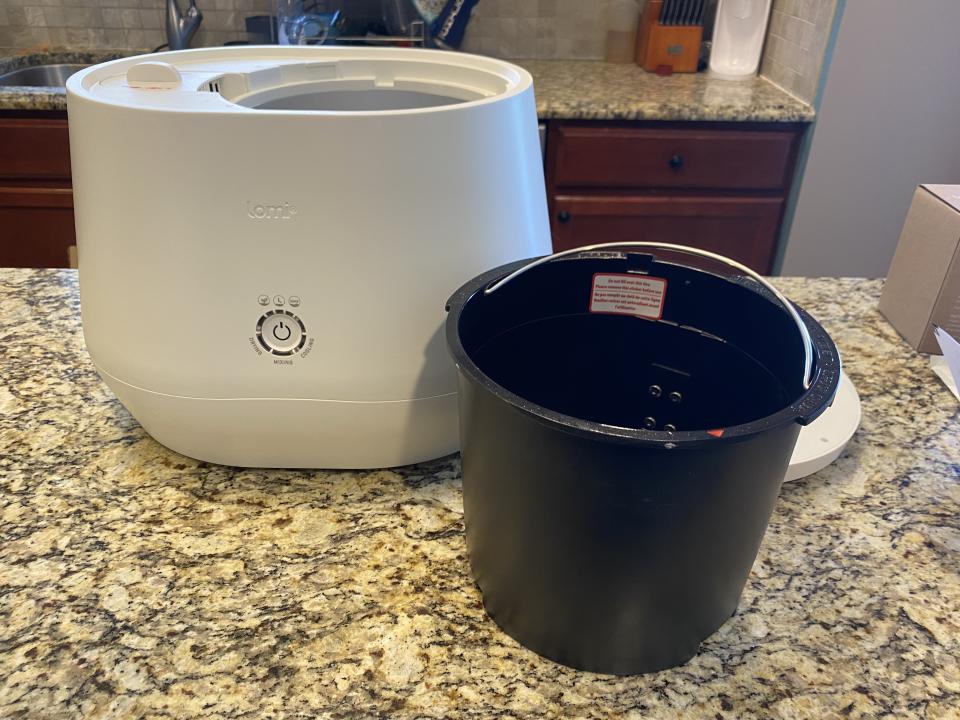
Buy: Lomi Electric Home Composter $499.95
Buy: Lomi Home Composter $499.00
We gave the Lomi its well-deserved love in a separate review, but it’s worth revisiting. The Lomi hit the market earlier in 2022 after considerable hype and has lived up to it. What did we love most? The option of having three cycles is great for running quick loads of easily broken-down waste (Eco-Express cycle, 3-5 hours), heavier loads for a richer compost (Grow cycle, 18-20 hours) or even approved bioplastics (5-8 hours). It’s completely odorless, quiet (not silent) and is a solid workhorse even when given twice-daily loads to process. It tackled some seriously gross leftovers and churned them down into dry, odorless, fully mature and plant-ready compost in 20 hours.
Lomi’s charcoal filters are easy to change and work exceedingly well in devouring any bad smells. Word to the wise: Be sure to order Lomi Pods to get the best results — they’re microorganism-rich tablets that help break down the waste and create richer soil. Nail those small details and the Lomi is an everyday eco-warrior that’s easy to master.
Pros:
Three cycles to choose from
Aesthetically pleasing design
Exceptionally simple setup and instructions
Creates the best amount of compost of all tested units
Cons:
Lid design is clunky and hard to close
Large heat output
2. Vitamix Food Cycler
RUNNER UP
Best for: Anyone who wants most of the features of the Lomi for $100 less.
Why We Chose It: We came for Vitamix’s great brand reputation and stayed for this easy-to-run and super-efficient composter.
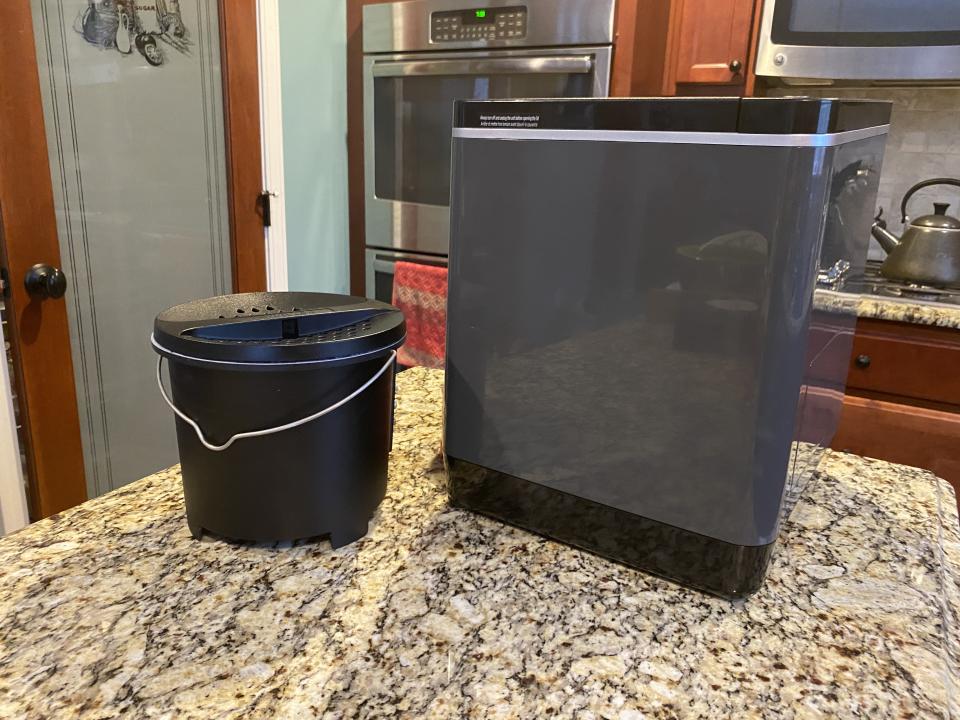
Buy: Vitamix Food Cycler $371.74 (orig. $399.95) 7% OFF
Buy: Vitamix Food Cycler FC-50 $399.95
Vitamix has a reputation for producing top-of-the-line kitchen appliances, so it’s no surprise this electric composter was our runner-up and a very close second to the Lomi. The Vitamix Food Cycler takes up less space on the countertop, and we don’t love the more utilitarian design. However, we did love the separate odor-killing lid that lets you keep the bucket separate from the unit as it fills. Like the Lomi, the Vitamix was completely free of any odors and quiet, albeit not silent.
With only one button, the operation could not be simpler, although we did miss having extra cycles to choose from, especially a quick cycle for smaller loads. And the Vitamix breaks down waste more thoroughly than the Lomi, which results in a slightly smaller output of compost. So far our indoor and outdoor plants seem very pleased with both the Vitamix and Lomi compost. And also like the Lomi, the Vitamix endured daily and sometimes twice-daily running without fail or complaint. If you won’t miss the extra cycles and slightly less compost output, the Vitamix is the way to go since it will save you $100.
Pros:
Smaller profile, better fit on a countertop
Separate odor-killing bucket lid for storage
Easy one-button operation
Low noise and odorless
Cons:
Only one cycle
Creates less compost per bucket of waste
3. Tero
BEST DESIGN
Best for: Serious gardeners willing to do the research about their compost
Why We Chose It: The hinged lid, larger-capacity bucket and twin blades are bits of inspired design genius.
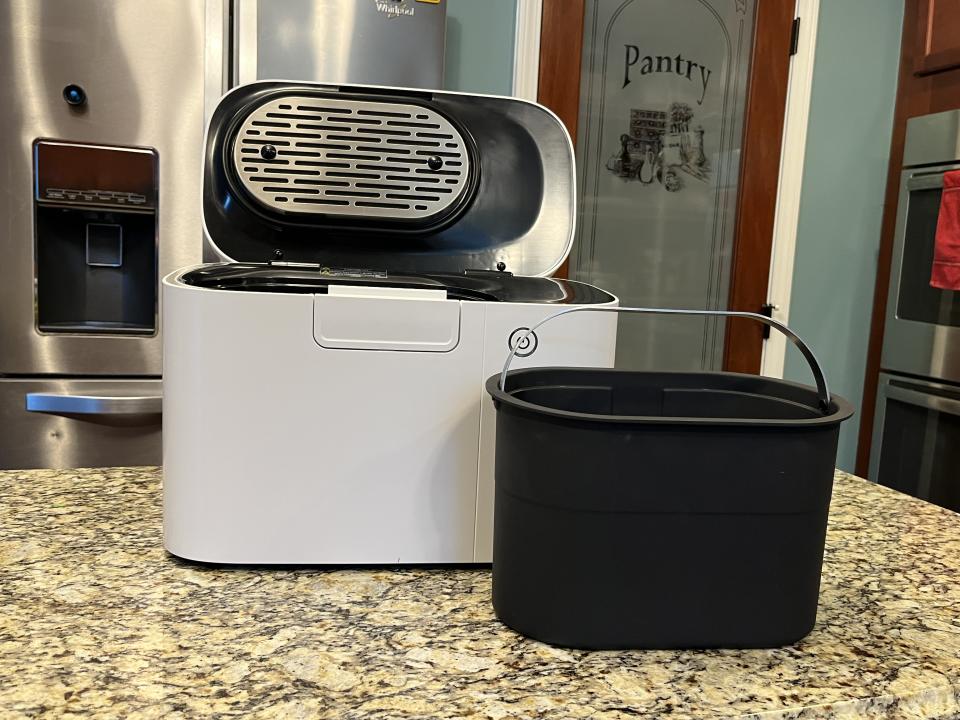
The Tero is truly a work of art, and it’s the best electric composter for gardeners. The hinged lid was a welcome feature after dealing with the lids of the Lomi and the Vitamix. That lid also houses the filtration unit, which means the Tero vents from the top and not the rear, which is a huge advantage because you can place it at the back of a counter or in a corner, whereas the back-venting Lomi and Vitamix advise against such placement. The Tero’s larger-capacity bucket has two food processor-like blades that are removable for easy cleaning. Design-wise, the Tero is truly unbeatable.
However, the Tero is a temperamental electric composter The instruction book is very specific about food waste that can and cannot be processed and those that can only be processed in small amounts. Cereals, fruits and vegetables create more potassium, which ensures the correct formation of plants’ stems; while legumes, fish and meat create more phosphorus, which aids plant growth and proper structure. Among the big no-no’s is any liquid, which we found the hard way in our first test when food juices created a failed batch.
If you’re diligent about separating your food waste, then the Tero is ideal for you. However, if you just want to grind up leftovers and coffee grounds, you may want to steer clear. The biggest advantage is for serious gardeners, as the Tero comes with a very detailed 24-page fertilizer guide.
Pros:
Can be placed at the back of the counter or corner since it vents from the top
Removable twin blades
Large capacity
Output is more nutrient-rich than other heat-driven composting machines
Cons:
Picky and unforgiving about what it can compost
Cannot process anything with liquid or juices
4. beyondGREEN All-Electric Pet Waste and Organic Waste Composter
ALSO CONSIDER
Best for: Pet owners who want to compost pet waste
Why We Chose It: It has a large-capacity (4 gallons) composter that can take 5 pounds of food and pet waste per day.
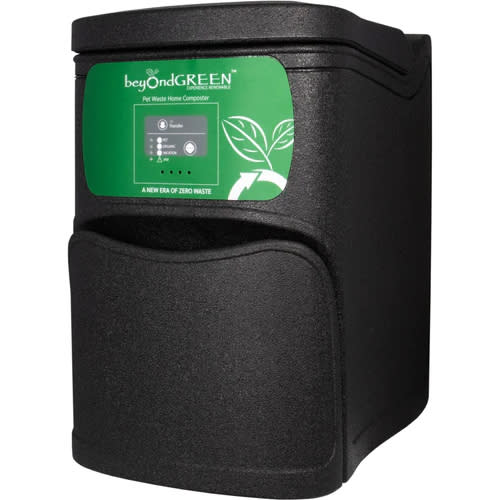
Buy: beyondGREEN All-Electric Pet Waste and Organic Waste Composter $449.99
While we didn’t get our hands on this unit for testing yet, we added it to the list because this large electric composter has two separate bins, with waste going in the top and the bottom free for curing compost. We love the idea of a large electric composter than can also tackle pet waste and the bags you pick it up with (provided those are the biodegradable bags sold by beyondGREEN.)
We’re less sold on a unit that takes up to five days to produce a batch of compost, even if it is Energy Star Certified and made from recyclable material. But the beyondGREEN also handles meat, fish and dairy, some of which can throw lesser units for a loop, and even wood shavings. It has three cycles: Pet (high), Organic (medium) and Vacation (low), and requires baking soda and sawdust pellets (provided) to produce optimally rich compost. It is also advertised as able to run both indoors and outdoors. Think of the beyondGREEN as the midway stop between an outdoor composter and an appliance-like countertop electric model.
Pros:
Large capacity (4 gallons)
One of the very few composters that takes pet waste
Energy Star Certified
Also composts beyondGREEN dog and cat waste bags
Cons:
Takes up to 5 days to compost
5. Reencle Prime
COMING SOON
Best for: Continuous use and constant refilling
Why We Chose It: Reencle Prime works around the clock and can be refilled and emptied on the fly, which would be a quantum leap in home electric composting.
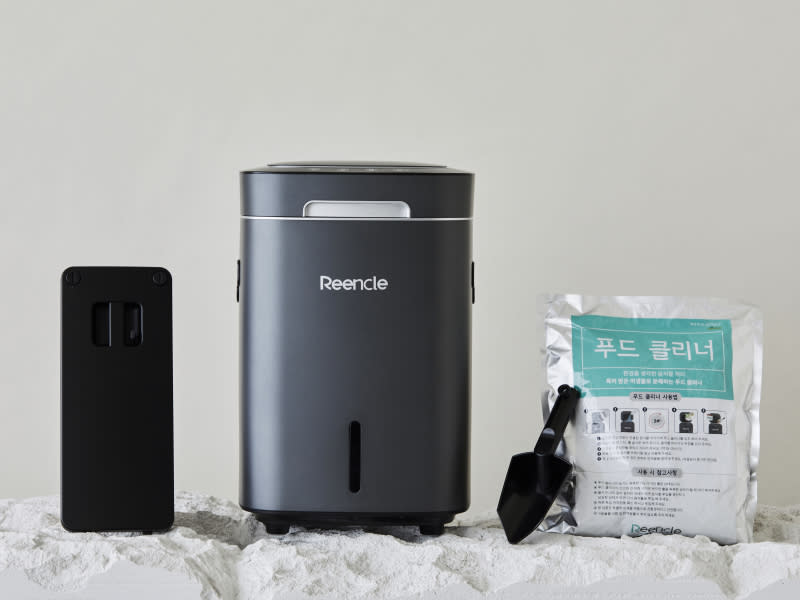
Reencle Prime is a current Indiegogo darling, and based on the pitch and the reviews from the show floor of CES 2022, we’re mightily intrigued. The big draw with the Reencle Prime is that it works continuously, meaning you do not have to wait for a cycle to complete to add more food waste or to remove compost: It can be added to and emptied on the fly. Which, if achieved, is a big step forward for home composters.
The Reencle Prime is best situated on the floor, and a touchless foot motion sensor opens and closes the lid like a trash can. It also claims a whisper-quiet 28dB operating sound level, which is significantly quieter than any other electric composter on the market. The secret to its rapid cycles — as short as two hours depending on the food waste — is Reencle’s proprietary ReencleMicrobe additive, which is self-perpetuating and acts to break down foodstuffs more thoroughly and with a richer output. The Reencle Prime is just beginning to ship now, and we hope to test it shortly.
Pros:
No more waiting for a cycle to end before refilling
Touchless foot motion sensor to open and close lid
Microbe additive is self-replicating
Claims to handle a wide range of food wastes
Cons:
None that can be claimed without testing
How We Chose The Best Electric Composter: About Our Testing Process
We received test units of the Lomi, the Vitamix Food Cycler and the Tero, and put them through daily testing with various food waste products based on the instructions provided with the units. As with all SPY reviews, we wanted to find pros and cons so that our readers can make informed choices. As we test additional electric composters, we’ll update this guide with new information.
We tested each of the composters we tested according to the following criteria, assigning each composter a score in each category. When our testing was complete, we compared the final scores to determine our overall product selection.
Ease of setup and use: We assessed how quickly we could get the unit from unboxing to working, and with what degree of difficulty.
Size: Some electric composters work better on countertops than others. Taller units won’t work beneath cabinets, square units are better for corners, etc.
Noise: The grinding and processing of food waste is louder in some units than others. We put equal amounts of the same food waste into the units and compared the sound outputs.
Odor: All of the tested units came with a form of odor filtration, usually carbon-based and we made sure to note if there were any lingering odors.
Finished product: The amount and the consistency of the compost created by electric composters can vary widely. Some give very specific instructions on which foodstuffs create which form of compost — some did not allow liquid to be used, some came with bio-additives like Lomi Pods — and we followed the instructions. Beyond that, we were careful to use the same types of food waste in each machine.
Durability: We ran each unit at least once a day to see how they held up to continuous use.
How Does an Electric Composter Work?
An electric composter might work differently from a traditional one, but that doesn’t mean it’s harder to operate. In fact, in choosing the best electric composter, that was a key criteria for our product testers — how easy is it to operate? For many of them, it’s as simple as pressing a button, closing a lid and waiting a few hours.
An electric composter consists of:
Hopper: Where added wastes are held before they’re composted
Motorized wand: A mixing wand that continuously turns the mixture
Heater: Dehydrates content and speeds up composting
Carbon filter: Absorbs the smell of the food
Air pump: Introduces oxygen to feed microorganisms in your soil
Cure tray: Collects final compost products
Drip tray: Collects leftover liquid
Pro tip: Save the liquid in your drip tray as a nutrient-rich alternative to regular water for plants.
The best electric composters operate according to the same overall process. They use heat, aeration and pulverization to reduce the volume of food waste, just like a regular composter. First, the composter employs a drying process, which kills plant diseases and pathogens. Then, it grinds your scraps into a compost pile, breaking down the volume even more into tiny, powdery particles and fertilizer. Finally, it cools the contents to room temperature, so you can handle it safely. The steps are as follows:
Food waste is placed in the machine.
Food waste moves to a chamber where heating, mixing and aerating occur, shrinking it in size.
Final food waste is deposited into a cure tray where it becomes fertilizer.
Some models only mix and dehydrate, while other machines utilize enzymes, which can affect the speed of food decomposition.
However, unlike normal compost piles, the result with a food cycler ends up 100% dry and sterile. And unlike normal compost methods, an electric version greatly reduces the emissions and odor of food waste, completing the composting process much faster than non-electric models.
What To Consider When Buying an Electric Composter
Size: Most electric composters are appropriate for counter or cabinet storage, but if you have a tiny kitchen, measuring beforehand is a good idea. The higher your want the capacity to be, the larger your composter will be.
Time: Usually, these machines take up to eight hours to do their business, but it can take some electric composters days to make fertilizer. While they’re all faster than conventional composting methods, certain models take as little as three hours. Most of them also make some noise when operating, so this is another factor to consider along with the runtime.
Capacity: Two to five pounds is the average amount of food waste an electric composter can process. If you have a very large family or lots of roommates, consider a high-capacity model.
Aeration: This is arguably the most important part of the process, allowing your food to break down minus the methane. The aeration structure should be spacious.
Price: You won’t find one much cheaper than $300, and the pricier ones can cost up to $1,000. Be sure to research whether you’ll need to purchase additional enzymes or additives to use the machine.
FAQs About Electric Composters
Is the compost created the same you can buy at gardening stores?
No, it’s a drier mix with fewer bacteria content, so it is not meant to replace planting soil. But it is nutrient-rich enough to be an excellent additive to both houseplants and outdoor vegetable and ornamental plants.
Does the heat generated mean electric composters are electricity hogs?
No, the beyondGREEN is Energy Star Certified. The Vitamix Foodcycler uses about one kilowatt-hour, roughly the same as the laptop you may be reading this on. These are energy-efficient machines in addition to being environmentally beneficial.
What are the benefits of an electric composter?
Electric composters significantly cut down on the three things most people hate about composting — the mess, the smell, and the time required to break down organic matter. In addition, outdoor compost bins can be a magnet for beehives and pests of all kinds, whereas electric composters operate quietly (and without foul odors) inside your home.
What Are the Benefits of Composting?
While many people are reluctant to buy a new kitchen gadget that takes up counter space, an electric composter has tons of benefits — especially if you have any plants.
While all kinds of composters help you live more sustainably, some might argue that an electric composter is better for a few reasons. First, it can break down ingredients that aren’t regularly compostable, like bones, meat and fish. An electric composter is an ideal indoor alternative if you live somewhere that’s too cold to compost outdoors, or if you live in an urban area where outdoor composting isn’t an option.
Investing in the best electric composter can also help you minimize your carbon footprint even further by reducing methane emissions, which composting bins and piles release into the air. Thanks to the aeration process in an electric model, this methane is eliminated.
When you take the trash out, it’ll be much less stinky. Plus, it gives you practically unlimited access to recycled soil, which is a major perk for home gardeners. Ultimately, going electric is faster, more compact, and more versatile than a traditional composter.
More Top Deals from SPY
Save 36% on Calvin Klein Underwear During Prime Day - Sale Ends Soon
Gildan White Cotton T-Shirts Are Just $2.60 for a Limited Time
Get 4 Months of Amazon Music Unlimited for Free During Prime Day - Offer Ends Soon
Best of SPY

